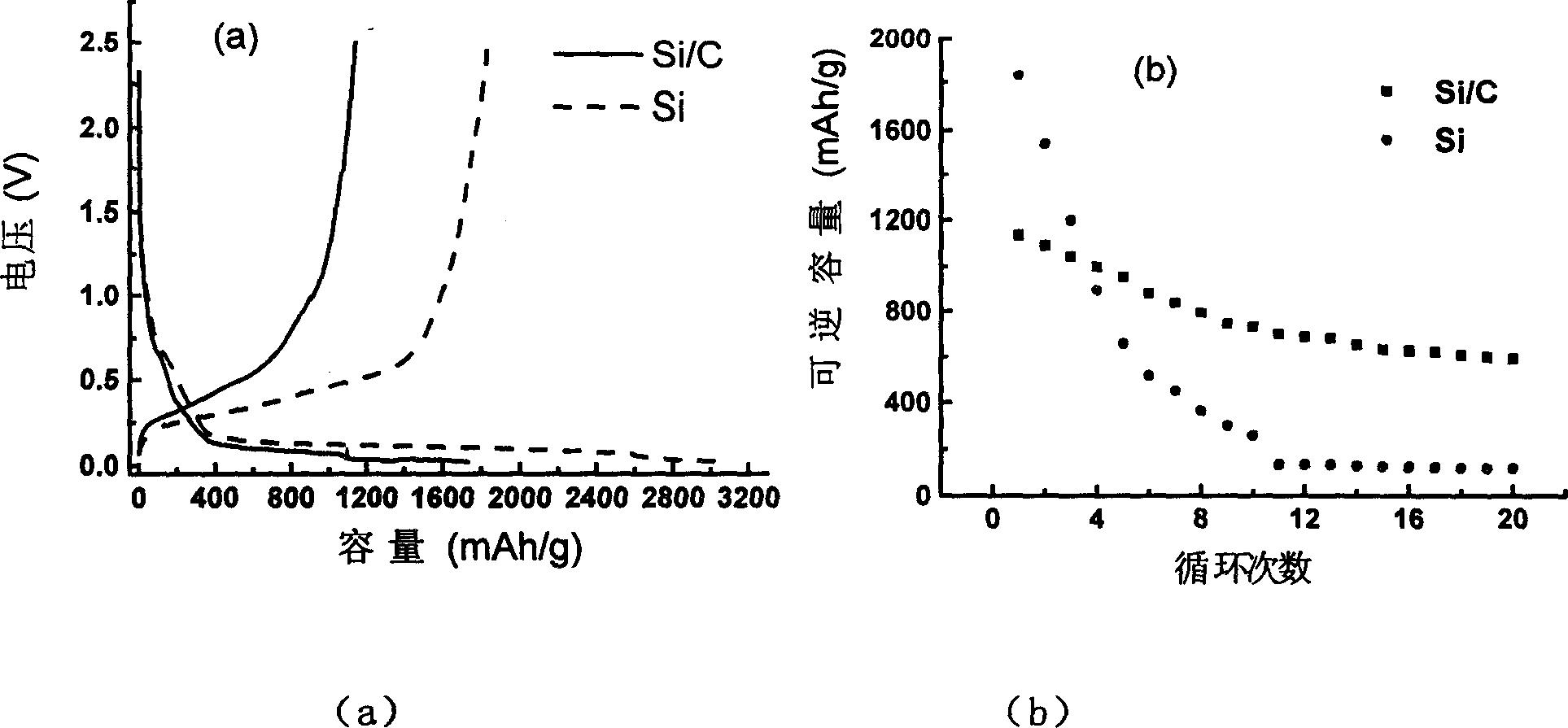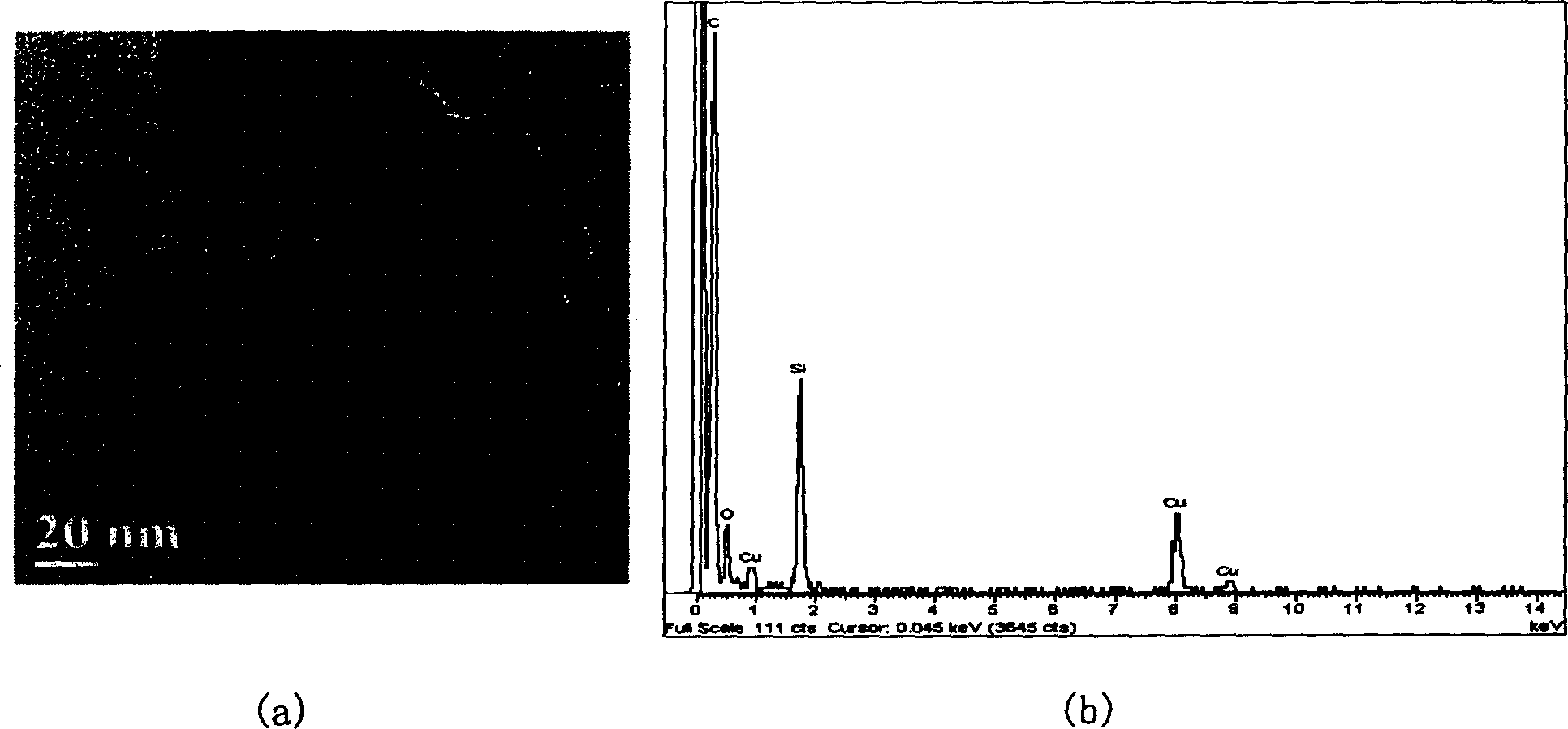Silicon/charcoal core-shell structure nanometer composite material and its preparation method and uses
A nano-composite material, core-shell structure technology, applied in structural parts, electrical components, battery electrodes, etc., can solve problems such as unsatisfactory long-term cycle performance and loss of nanoparticles, and achieve stable product quality, uniform particle size, and dispersibility. good effect
- Summary
- Abstract
- Description
- Claims
- Application Information
AI Technical Summary
Problems solved by technology
Method used
Image
Examples
Embodiment 1
[0031] Add 0.5g of nano-silicon and 0.5g of polyvinylpyrrolidone into 200ml of water, and continuously ultrasonically disperse for 30 minutes to make the nano-silicon disperse evenly. Then add 1 g of sodium lauryl sulfate, and continue ultrasonic emulsification for 30 minutes. Then add 0.5 g of acrylonitrile (AN) and 0.005 g of potassium persulfate, and evacuate with an inert gas for 30 minutes under magnetic stirring. Stirring was continued, and the temperature of the oil bath was raised to 70° C. for emulsion polymerization under an inert atmosphere for 12 hours. After the emulsion polymerization is completed, the mixed liquid is centrifuged, and the product is dried at a temperature of 60° C. to obtain a brown micropowder, which is the nano-silicon / polyacrylonitrile precursor. The brown fine powder was calcined at 700° C. for 24 hours under the protection of an inert atmosphere to obtain a black silicon / carbon core-shell nanocomposite material.
[0032] The electrochemica...
Embodiment 2
[0034] Add 0.5g of nano-silicon and 0.5g of polyvinylpyrrolidone (polyvinylpyrrolidone) into 200ml of water, and continuously ultrasonically disperse for 30 minutes to make the nano-silicon disperse evenly. Then add 1gOP 9 , continuous phacoemulsification for 30 minutes. Then add 1 g of acrylonitrile (AN) and 0.005 g of potassium persulfate, and evacuate with an inert gas for 1 hour under magnetic stirring. Stirring was continued, and the temperature of the oil bath was raised to 70° C. for emulsion polymerization under an inert atmosphere for 12 hours. After the emulsion polymerization is completed, the mixed liquid is centrifuged, and the product is dried at a temperature of 60° C. to obtain a brown micropowder, which is the nano-silicon / polyacrylonitrile precursor. The brown micropowder was calcined at 750° C. for 24 hours under the protection of an inert atmosphere to obtain a black silicon / carbon core-shell nanocomposite material. The transmission electron microscope a...
Embodiment 3
[0036] Add 0.5g of nano-silicon and 0.5g of polyvinylpyrrolidone into 200ml of water, and continuously ultrasonically disperse for 30 minutes to make the nano-silicon disperse evenly. Then add 1 g of sodium dodecylsulfonate and continue ultrasonic emulsification for 1 hour. Then, 1.5 g of styrene and 0.01 g of azobisisobutyronitrile (AIBN) were added, and the mixture was evacuated with an inert gas for 2 hours under magnetic stirring. Stirring was continued, and the temperature of the oil bath was raised to 70° C. for emulsion polymerization under an inert atmosphere for 8 hours. After the emulsion polymerization is completed, the mixed liquid is centrifuged, and the product is dried at a temperature of 60° C. to obtain a brown micropowder, which is the nano-silicon / polystyrene precursor. The brown micropowder was calcined at 800° C. for 16 hours under the protection of an inert atmosphere to obtain a black silicon / carbon core-shell nanocomposite material. The electrochemica...
PUM
| Property | Measurement | Unit |
|---|---|---|
| particle diameter | aaaaa | aaaaa |
| thickness | aaaaa | aaaaa |
Abstract
Description
Claims
Application Information
 Login to View More
Login to View More - R&D
- Intellectual Property
- Life Sciences
- Materials
- Tech Scout
- Unparalleled Data Quality
- Higher Quality Content
- 60% Fewer Hallucinations
Browse by: Latest US Patents, China's latest patents, Technical Efficacy Thesaurus, Application Domain, Technology Topic, Popular Technical Reports.
© 2025 PatSnap. All rights reserved.Legal|Privacy policy|Modern Slavery Act Transparency Statement|Sitemap|About US| Contact US: help@patsnap.com


